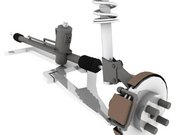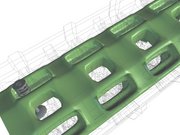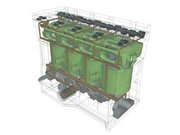User:Wapcaplet/Auto diagrams
|
|
| Contents |
Automotive diagrams
Wikipedia could use some illustrations for automobile parts; I've begun working on 3D models using Blender of the significant components of an automobile, with the intentions of using them to show where certain parts are, how they relate to other parts, and how they function. My initial goal was to give a generalized view of the engine compartment, but I'm starting to overstep the scope, in what I think is a good direction: lots of detail. Below are some comments about my current plans and progress on the model.
If you are interested in getting a copy of the .blend file for the model, let me know. If you know stuff about cars and want to comment on what I have so far, leave a message on my talk page.
I've started a new WikiProject to give these diagrams a home, when they're eventually done. See Wikipedia:WikiProject Automobile construction.
Current plans
Plans right now are to (eventually) render still-images, most likely JPEG or PNG. Conversion to Flash has been suggested, but I am not interested (nor likely capable) of doing this for several reasons: Blender does not currently support Flash export (though it has been proposed); Flash is somewhat of a non-free format, in that it's controlled by Macromedia (unlike SVG, which I think would be a better format to use); and I personally find Flash on most websites highly annoying. The possibility of rendering animations is quite high, though it may be a while before they would be practical for Wikipedia, not least because there is currently no open video format. Once Theora becomes a reality, maybe.
Drum_brake_testrender.jpg
Engine_block_bottom_testrender.jpg
Engine_block_top_testrender.jpg
Engine_block_internal_testrender.jpg
Piston_crankshaft_testrender.jpg
Cylinder_head_bottom.jpg
Cylinder_head_top.jpg
Engine_complete_external.jpg
Current progress and renderings
Here are some preliminary test renderings. I've been playing around with the new release of Blender, which supports rendering in Yafray (http://www.yafray.org/), a damn fine raytracer. With default lighting and only a minimum of tweaking, it can produce fairly photorealistic images. Anyhow, the thumbnail shows a test rendering of the current suspension and power steering gear. Materials are not final, just temporary for testing. Car parts are never that shiny :-) Final versions are more likely to be color-coded for easy reference.
Though you can't see it in the render, the power steering assembly is quite complete---all of the components are there for illustrating how the power steering fluid gets routed to the rack piston. The nicely-meshing pinion and rack are in there too. Animating it may be a possibility, but I'm not thinking about that quite yet. At some point I'll have to devise clever cutaway views of the valve to show how it all works. The whole power steering assembly needs to be rotated towards the driver (to the right in the image), but that comes later.
Also shown is the completed drum brake for the rear wheel. I'm thinking of cleaning up some of the obviously-polygonal edges, especially on things that are supposed to be round (like the hub).
Completed portions
The following are parts of the model that are fairly complete, and could be used with little modification for illustrating articles on related topics. If you're interested in getting some renders of these parts, let me know and I'll post some.
- 02/25/04:
- Disc brake - brake caliper and piston
- Power steering - complete rack and pinion assembly, steering linkages, and rotary valve for delivering fluid to either side of the rack piston
- Constant velocity (CV) joint - tripod-style CV joint with spider bearing assembly
- Ball-and-cage style CV joint - used for the inner CV joint
- Drum brake - used on rear wheels. Drum, pads, cylinder, adjusting lever and adjuster, parking brake lever, springs.
- Front suspension, wheel bearings on front and back
- The full model contains about 28,000 polygons, and the .blend file is around 1MB.
- 02/25/04:
- Engine block - I was going to save this for later, but practically every other significant engine component connects to it somehow, so it needs to be done. So far, I've only finished a rough start on the cylinder block; the cylinders and water jacket are basically done, but I need to figure out how to connect the water pump, any bypass hoses, the oil pump and oilflow passages. The cylinder head and oil pan will be next, followed by the pistons, crankshaft, valves, camshafts (this model is a dual overhead cam), intake and exhaust manifolds... the list goes on. Stay tuned.
- 02/28/04:
- After spending a few hours studying every engine block photo and diagram I could find, I think I know how I'm going to connect everything together. The water inlet is now there, as are the main oil galleries. It'll be a full force feed lubrication system, which means that the pressurized oil travels through passages in the crankshaft into passages in the piston connecting rod, and from there into the pistons. Passages leading to the cylinder head are also now in place. Haven't yet figured out how oil gets back down into the oil pan from the cylinder head, so I'm making an assumption that a particular largish passage I've seen down the side of many engine blocks is in fact a drain for the oil coming from the head. (Someone please correct me if I'm way off base here!) Anyhow, I only need to finish building the walls and base of the block, complete with bolt holes for attaching it to the oil pan. When it's done I'll post a rendering. The engine block alone is around 3,200 polygons right now.
- The engine block is essentially done. Haven't added bolt-holes to the base yet; I may just skip those, since it doesn't add anything significant. Check out the renders.
- 03/02/04:
- Piston, connecting rod, and crankshaft mostly complete. Crankshaft and connecting rod have drilled passages for oil flow (visible as small holes in the rendering). Piston uses full-floating pin.
- Piston rings and bearing caps. Had to tweak the engine block to allow the crankshaft counterweights to clear the pistons; it wasn't quite tall enough. Engine block and contained components are around 8,000 polys.
- 03/10/04:
- Finally, after some hesitation, determined to not include any bolt-holes or bolts (aside from functionally significant ones) in the model. Removed existing bolt-holes from engine parts. Got bronchitis for a week and took a break from modeling.
- 03/19/04:
- Getting back into modeling. Did some more tweaking and got most of the oil pump done (rotary type).
- 03/31/04:
- The oil pump, oil strainer, oil filter and oil pan are complete. Began work on cylinder head; valve mechanism is done and a portion of the head. Got a cheap auto textbook that should help.
- Cylinder head is coming along nicely. Test renderings show the bottom and top of the head, as well as an internal view of the water jacket (which was actually less of a headache to model than I expected it to be). Next challenge is routing the oil inlets to the bearings, and the oil drainage back into the engine block. The engine block, cylinder head, and contained components are around 25,000 vertices (7,000 just in the cylinder head water jacket). Blender is finally beginning to exhibit slight sluggishness during modeling :-)
- 04/07/04:
- Working on the issue of animation; starting to figure out armatures in Blender, and have managed a rudimentary animation of the pistons and crankshaft turning. Started work on the camshafts and made some adjustments to the head.
- 04/08/04:
- Considering the camshafts in depth. Went to HowStuffWorks (http://www.howstuffworks.com) to see the intake/exhaust in detail, only to find out that I'm pretty sure they got it wrong (http://auto.howstuffworks.com/engine4.htm)! According to at least three (http://www.tpub.com/content/construction/14264/css/14264_58.htm) other (http://stangcrazy.com/tech/techarticles/valvetimingchart.htm) sources (http://www.compcams.com/Base/Images/Technical/800-615-ValveTimingIllustration-002.gif), the exhaust valve opens well before bottom dead center, is open at the same time as the intake for a while, and the intake doesn't close until almost halfway up the next stroke. And I can't begin to list all the things that are wrong with this animation (http://auto.howstuffworks.com/engine10.htm). Anyhow, I'm anxious to get this part of the model done so Wikipedia's how-engines-work articles can be more correct. Also got the rest of the oil galleries/drains in the head finished, and tried out some animation on the disc brake. Gotta figure out how to attach the distributor to the camshaft... Engine is at 35,000 vertices (which will increase by 22,000 once I create 15 more valves and the second camshaft).
- Completed cylinder head and cylinder head cover. Two new renders added showing internals of the entire engine assembly and a nice Yafray render of the outside. Don't pay any mind to the materials, colors, lighting, etc. - it's still just in the test-render phase!
- 04/10/04:
- Valves and camshafts finished. Set up everything for animation, and (I hope) got all the timings right. New render showing pistons, crankshaft, camshafts and valves. Pondering how to clearly illustrate the stroke cycle of a single cylinder.
- 04/11/04:
- The first illustrations are now in use for Four-stroke cycle and Reciprocating engine.
Planned eventually, but probably not for a while:
- Transmission (preferably automatic, if I can find some good diagrams; probably more complicated than the entire engine block)
Additional possibilities will be listed here as I work on them. Most of the significant parts of the engine are likely to be fully detailed, so they might be used to illustrate how an engine works.
Basis for the model
I'm primarily basing the model on illustrations in the repair manual for my wife's 1990 Toyota Corolla, so decisions about what kinds of part to include are influenced heavily by that fact. I will almost certainly be using a 4-cylinder, 16-valve engine, and if possible, an automatic transmission. Features or capabilities that this car does not have (like anti-lock brakes, airbags, etc.) will most likely not be included (not yet, anyway).
Where the illustrations or information in that manual are lacking, I've been using the repair manual for my 1992 Buick Century - in particular, the CV joints are strongly based on that vehicle. Where illustrations in either are lacking or insufficient, Google has pulled through and provided myriad other resources for all sorts of generic and specific vehicles and the design of their parts.
Of course, occasionally, it helps to actually go out and look at the car itself :-) I am not a mechanic by any stretch of the imagination, so any criticism or suggestions regarding the model by someone with more hands-on automotive experience would be greatly appreciated. Leave a message on my talk page if you have any comments.
A web resource that I've recently discovered is Integrated Publishing (http://www.tpub.com/), a site that makes electronic publications available for purchase (quite inexpensively) in addition to providing HTML versions (albeit somewhat poorly formatted) on the site. A phenomenal amount of useful books and reference materials which seem to be targeted towards students of various disciplines. I'll definitely be using this site frequently in creating my model, and would highly recommend it to anyone interested in working on writing any mechanics-related articles.
I found another resource at a local thrift store: a textbook published in 1977 by the Hearst Corporation entitled Auto Engines & Electrical Systems. It's more than 800 pages and has lots of great illustrations and photos; already it has answered a couple of questions that couldn't be answered with extensive Googling, so it should definitely be worth the $5.00 investment. It only covers the engine and related parts, and of course only covers technology up to 1977, but car engines have changed little enough since then that it's easily applicable to my model.




